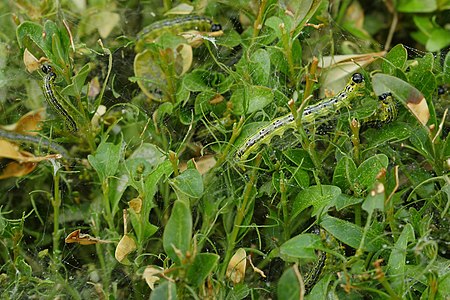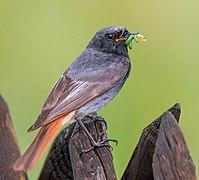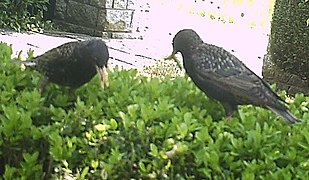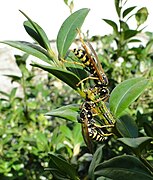Box tree moth
| Box tree moth | ||||||||||||
|---|---|---|---|---|---|---|---|---|---|---|---|---|

Box tree moth |
||||||||||||
| Systematics | ||||||||||||
|
||||||||||||
| Scientific name | ||||||||||||
| Cydalima perspectalis | ||||||||||||
| ( Walker , 1859) |
The cydalima perspectalis ( Cydalima perspectalis ) is an East Asian small butterfly of the family of Crambidae , the beginning of the 21st century for Central Europe was introduced and today the invasive species has developed. The caterpillars can cause damage to boxwood by scavenging .
description
butterfly
The moth reaches a wingspan of about 40 to 45 millimeters. The forewings are mostly colored silky white and provided with a wide black-brown band on the front edge and on the hem. A small, brown-colored bulge in the central field and a crescent-shaped, white spot next to it are noticeable. The hind wings are also silky white and show a broad brown border. Sometimes completely brown-colored specimens appear, but the white spot is present.
Caterpillar

The caterpillars are up to five centimeters long, yellow-green to dark green and black and white striped, with black dots, white bristles and a black head capsule.
Geographical distribution and occurrence
The box tree moth is native to East Asia ( Japan , China , Korea , India , the Far East ). In Europe it appears as a neozoon - presumably through the international trade in tree nursery goods : it was first reported from Germany in 2006, then from Switzerland and the Netherlands in 2007 ; 2009 from France , Great Britain and Austria ; In 2011 the box tree moth was first reported from Hungary, Romania and Turkey; he is also known from Slovakia and Belgium .
In Central Europe, its caterpillars were first found in Germany, first in Baden-Württemberg , in the Basel area and on the Upper Rhine , then also in Hesse , North Rhine-Westphalia and the Netherlands . In connection with a simultaneous infestation of the stock with the tubular fungus species Cylindrocladium buxicola near Basel, it also led to the complete death of a centuries-old boxwood forest near Grenzach-Wyhlen by 2011 .
In Switzerland, the distribution area of the box tree moth expanded significantly in 2012. Major damage was reported from various parts of the country.
Caterpillars were also found in Austria : 2009 in Vorarlberg , 2010 in Lower Austria . It is now widespread in Vorarlberg, Lower Austria and Vienna and also appears in Styria, Carinthia, Burgenland and Upper Austria. In 2013, the boxwood moth was also detected for the first time in Spain and Denmark , especially on Sjælland .
The first evidence for the fauna of Bavaria was a butterfly found on July 4, 2010 in Nuremberg in the Gebersdorf district.
Further reports show that the box tree moth can already be found in many federal states.
Way of life
The moths sit on the underside of leaves, usually not on box trees , but on other plants. They can fly well and quickly and come out at night. The lifespan of the females is about eight days. They specifically look for box trees to lay eggs; up to four generations of boxwood moths can emerge per year. The last egg-laying caterpillars of the year overwinter in cocoons between the leaves or in cracks near the plants. For protection, they stay in chambers that are formed from leaves and glued together with threads that are produced by the caterpillar itself. In the event of danger, she can also quickly lower herself on such a thread. The cocoons are very tightly woven and make it difficult to control these harmful insects.
In Central Europe , the caterpillars go through six to seven larval stages from mid-March to early April (starting from a temperature of 7 ° C) until pupation . It can be assumed that from spring to late summer a new generation of boxwood moths will emerge approximately every 2 to 3 months. The female boxwood moths also prefer to lay eggs that have not yet been infested, which in turn favors the spread. The caterpillars cause devastation on various types of boxwood, such as the common boxwood ( Buxus sempervirens ), which is native here , and in Asia, on the other hand, also on the small-leaved boxwood ( Buxus microphylla ), which is rare in Germany . This is common here in the varieties koreana and japonica in the trade.
In China , the box tree moth also causes damage to the Buxus sinica, which does not occur in Germany . Depending on the region, three to five generations appear in China each year. In Japan it is assumed that there are two to four generations per year. In East Asia it forms three to four generations per year, in Central Europe, depending on the weather and temperature, at least two. For Germany, three generations are reported, while in Switzerland and Austria two generations appear.
Toxicity
The boxwood moth larvae store some of the more than 70 known boxwood poisons , in particular dibasic triterpenes ( alkaloids ), while monobasic triterpenes are more likely to be metabolized and less stored. The young caterpillars prefer the older leaves inside the bush, which have a higher content of toxins. This makes the smaller caterpillars in particular unattractive in terms of taste and also poisonous for potential predators . Nevertheless, songbirds (especially titmice ) have been observed repeatedly feeding large boxwood moth caterpillars to their offspring.
Damage effect and pattern
In many areas, especially in the Basel area , the species occurs increasingly as a forest pest . The box tree moth also causes significant damage in private and public gardens. The damage is not to be confused with boxwood diseases, for example the Cylindrocladium shoot death , the Volutella branch death and the box wilt . The caterpillars of the boxwood moth first eat the leaves, then also the green twig bark. On the leaves of infected plants, only the leaf veins or the leaf stalk and remnants of dried, light beige leaf tissue remain. In between there are also some healthy, green leaves. The whole plant is surrounded by a web. Light green droppings are visible in the web and under the plant. If it is very heavily eaten, individual shoots or even the entire plant can die off. Usually the plant sprouts again.
Combat
Regular checks of the box trees from March to October allow early detection of infestation. Combating with sprays should be done as directly as possible and with sufficient pressure. The biological control of the larvae on the basis of the beneficial insects-friendly Bacillus thuringiensis ssp. kurstaki showed an excellent effect in an experiment by the Zurich University of Applied Sciences (ZHAW) in 2012. Corresponding preparations are available from agricultural and gardening shops. There are chemical control options in the form of thiacloprid , which is harmful to livestock such as z. B. bees is; or acetamiprid . In Asia, farmers also use neem oil to control the box tree moth.
Other methods of combating this include the use of pheromone traps or light traps .
The box tree moths can be sprayed over a large area and collected using a high-pressure jet and collecting foil. Some hobby gardeners report that they were able to prevent hatching butterflies from flying off and other butterflies from entering the box by hanging their box trees with a bird protection net with a 10 mm mesh size. At the beginning of the epidemic, the box tree moth had few natural enemies in Germany. It is now increasingly observed that native bird species such as sparrows , great tits and chaffinches as well as several wasp species specifically seek out infested box trees and consume the caterpillars. Domestic chickens also eat moths and fallen pupae.
Black redstart with boxwood moth caterpillars
Starlings eat caterpillars of the boxwood moth
Wasps eliminate boxwood
moth caterpillarsAnt transporting a boxwood
moth caterpillar
Systematics
A current study on the genus of the boxwood moth suggests that it belongs to the genus Cydalima . The authors mention two synapomorphic features that characterize Cydalima as a monophyletic group: 1. the sclerotization of the ductus bursae anterior of the ductus seminalis in the female genital and Costalrand extends into it. In this context, the monotypic genus Neoglyphodes Streltzov, 2008, is synonymous with Cydalima .
Synonyms
- Phakellura perspectalis (Walker, 1859)
- Diaphania perspectalis (Walker, 1859)
- Palpita perspectalis (Walker, 1859)
- Glyphodes perspectalis (Walker, 1859)
- Neoglyphodes perspectalis (Walker, 1859)
Photo gallery
Web links
- Lepiforum e. V. Identification aid
- Box tree moth: what to do? A BUND information
- photos
- GlobIZ - Global Information System Common Moth (in English)
- Cydalima perspectalis at Fauna Europaea. Retrieved October 4, 2011
Individual evidence
- ↑ Species profile
- ↑ Vorarlberg Chamber of Agriculture : Box tree moth active again. In: Fruit and Garden Culture Vorarlberg .
- ↑ Fauna Europaea
- ↑ a b Richard Mally, Matthias Nuss: Phylogeny and nomenclature of the box tree moth, Cydalima perspectalis (Walker, 1859) comb. n., which was ecently introduced into Europe (Lepidoptera: Pyraloidea: Crambidae: Spilomelinae) . In: European Journal of Entomology . 107, No. 3, 2010, pp. 393-400. doi : 10.14411 / eje.2010.048 .
- ↑ . Safian, Sz & B. Horváth, 2011: Box Tree Moth - Cydalima perspectalis (Walker, 1859), new member in the Lepidoptera fauna of Hungary (Lepidoptera: Crambidae). - Natura Somogyiensis 19: 245-246.
- ↑ Székely, L., V. Dinca & C. Mihai 2012: Cydalima perspectalis (Walker, 1859), a new species for the Romanian fauna (Lepidoptera: Crambidae: Spilomelinae). - Buletin de Informare Entomologica 22 (3-4): 73-77
- ↑ Hizal, E., M. Kose, C. Yesiland & D. Kaynar 2011: The New Pest Cydalima perspectalis (Walker, 1859) (Lepidoptera: Crambidae) in Turkey. - Journal of Animal and Veterinary Advances 11 (3): 400-403.
- ^ Lepidoptera of Belgium
- ↑ Leaflet from the Basel City Gardening Department, Building and Transport Department of the Canton of Basel-Stadt. PDF for download at the bottom of the page
- ↑ http://www.bern.ch/mediencenter/aktuell_ptk_sta/2012/07/buchbaumsch
- ↑ The box tree moth is raging like never before. Retrieved May 26, 2020 .
- ↑ News - TOP ONLINE. Retrieved May 26, 2020 .
- ↑ Vorarlberg Chamber of Agriculture: Box tree moth active again. In: Fruit and Garden Culture Vorarlberg .
- ↑ Determination aid of the Lepiforum: Cydalima Perspectalis. Retrieved May 26, 2020 .
- ↑ Boxwood moth plague in Carinthia The boxwood moth eats its way through Carinthia's gardens
- ↑ Identification aid of the Lepiforum: Cydalima Perspectalis Distribution III. Retrieved May 26, 2020 .
- ↑ galathea 3/2010 ( Kreis Nürnberger Entomologen eV )
- ↑ Determination aid of the Lepiforum: Cydalima Perspectalis distribution D NW. In: www.lepiforum.de. Retrieved August 30, 2016 .
- ↑ Information on Buchsbaummünsler.net
- ↑ a b c d H. Wan, T. Haye, M. Kenis, S. Nacambo, H. Xu, F. Zhang, H. Li: Biology and natural enemies of Cydalima perspectalis in Asia: Is there biological control potential in Europe ? In: Journal of Applied Entomology . Blackwell Verlag, March 19, 2014, doi : 10.1111 / jen.12132 (English, piralidedelbosso.it [PDF; 127 kB ; accessed on May 27, 2018]).
- ↑ Reinhold John, Jörg Schumacher: The boxwood borer (Cydalima perspectalis) in Grenzach-Wyhlener Buchswald: invasion chronicle and monitoring results . In: Springer spectrum (ed.): Healthy plants: Plant protection - consumer protection - environmental protection . Springer-Verlag, 2013, ISSN 0367-4223 , doi : 10.1007 / s10343-013-0292-7 ( researchgate.net [PDF; 1.6 MB ; accessed on May 27, 2018] with abstract in English).
- ↑ Florine LG Leuthardt, Gaetan Glauser, Bruno Baur: Composition of alkaloids in different box tree varieties and their uptake by the box tree moth Cydalima perspectalis . In: Chemoecology , Volume 23, No. 4, December 2013, pp. 203-212, doi: 10.1007 / s00049-013-0134-1 .
- ↑ Florine Lilly Gabriela Leuthardt: Distribution, Life History, Food Choice and Chemical Ecology of the Invasive Box-Tree Pyralid Cydalima perspectalis. Inaugural dissertation, Faculty of Philosophy and Natural Sciences at the University of Basel, 2013, p. 10 ( PDF ).
- ↑ Franz Meier, Roland Engesser, Beat Forster, Oswald Odermatt, Alexander Angst, Doris Hölling: Frost Protection Overview 2014 . In: WSL Reports , Issue 23, 2015, p. 11 ( PDF ( Memento of the original from October 13, 2017 in the Internet Archive ) Info: The archive link has been inserted automatically and has not yet been checked. Please check the original and archive link according to the instructions and remove then this note. ).
- ^ Swiss radio and television (SRF). Retrieved May 26, 2020 .
- ↑ Oelhafen, A. 2012: Box Tree Moth - Biological Control Options ( Memento of the original from June 13, 2013 in the Internet Archive ) Info: The archive link was inserted automatically and has not yet been checked. Please check the original and archive link according to the instructions and then remove this notice. (PDF; 4.9 MB) - g'plus “the gardening specialist magazine” 19/12, 36-37
- ↑ Entry in the national directory of plant protection products in Switzerland ; accessed on March 14, 2016.
- ↑ Box tree moth 2020 - Recognize and combat. Retrieved on May 26, 2020 (German).
- ↑ Archived copy ( Memento of the original from May 18, 2015 in the Internet Archive ) Info: The archive link was inserted automatically and has not yet been checked. Please check the original and archive link according to the instructions and then remove this notice.
- ↑ Box tree moth on Arbofux - diagnosis database for woody plants. Retrieved May 26, 2020 .
- ↑ Weißensberger finds means against the borer. Retrieved May 26, 2020 .
- ↑ Box tree moth: recognize, prevent & control - Plantura . In: Plantura . March 17, 2017 ( plantura.garden [accessed September 14, 2017]).
- ↑ Natural enemies of the boxwood moth? , Rhineland-Palatinate Garden Academy, accessed on July 8, 2018
- ↑ The locals have learned something new - animal helpers in the fight against the boxwood moth , Schwäbisches Tagblatt dated August 28, 2017, accessed on July 8, 2018
















